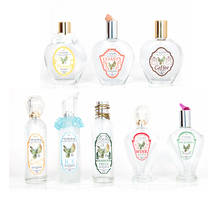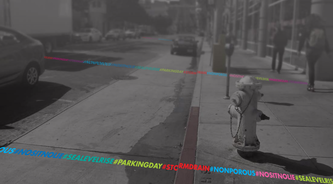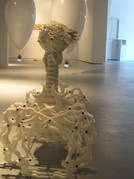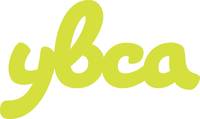Future Now
The IFTF Blog
Announcing Open City / Art City Featured Artists

Institute for the Future and Yerba Buena Center for the Arts are teaming up for Open City / Art City Festival on October 4 in San Francisco, a creative and generative event that looks at how we transform a city. The festival coincides with our 2014 Technology Horizons program's research conference, which focuses on the possibilities for life in an Open City--characterized by adaptability, shareability, participation, imagination, and equity. We asked artists to provoke our imagination with original, speculative experiences and artistic interpretations of Open Cities in the year 2024 or beyond.
The results are in!
The following artists will feature their interactive work throughout the festival, alongside a full day of talks, workshops, and panels. Read more about their pieces below, and the entire program on the festival website. See these works in person and have your own chance to think about the future of your city at Open City / Art City!
The Ephemeral Marvels Perfume Store by Catherine Sarah Young
Blog and Portfolio | Project Website | @catherineyoung
 The Ephemeral Marvels Perfume Store (T.E.M.P.S., French for time or weather) is a perfume line set in the future when many things would have disappeared because of climate change. This first collection features eight scents: Coasts, Coffee, Eucalyptus, Hardwood Trees, Honey, Ice, Peanuts, and Wine. Participants are invited to smell these perfumes and share their memories of the scents with fellow participants.
The Ephemeral Marvels Perfume Store (T.E.M.P.S., French for time or weather) is a perfume line set in the future when many things would have disappeared because of climate change. This first collection features eight scents: Coasts, Coffee, Eucalyptus, Hardwood Trees, Honey, Ice, Peanuts, and Wine. Participants are invited to smell these perfumes and share their memories of the scents with fellow participants.
As climate change continues to impact cities, I intended to design a sensory and accessible experience for us to reflect on the things we could lose. Smell, with its relationships to memory, is visceral and instantaneous. I hope to initiate conversations among people about their memories with the scents and hopefully inspire them to prevent these from disappearing from the natural world and being turned into luxury perfumes.
T.E.M.P.S. is part of The Apocalypse Project, a creative platform on climate change and environmental futures.
Creative Determinants of Health Station by Jeremy Liu
Creative Ecology website | Creative Determinants of Health website | @jeremycliu
The not-too-distant future city of 2024 will be increasingly challenged by the demands, responsibilities, and opportunities of density and diversity. While cities become the unique confluence of place and people and serve a central role in the future of humanity as the highest form of sustainable technology, we must also discover ways for people to live together, and together be healthier. In developing the Creative Determinants of Health, we follow two lines of inquiry: How we know what we know, and What we know is what we understand. The Creative Determinants of Health are a result of combining the concept of Creative Intelligences, the way in which people create an understanding of the world around them, with the Social Determinants of Health.
The Creative Determinants of Health Station addresses the growing dependency on technology as an all-encompassing interface with the world, a dependency predicated on utility over agency. The Creative Determinants of Health Station expresses our imagined future in a post-IoT (internet of things) and post-QS (quantified self) world where a revival of direct sensory awareness is resurgent and a sense of personal agency is proven to be the ultimate cure all.
Visitors to the Station will be invited to activate (with no log-in, registration or password required!) the innate sensor network of their own faculties, utilizing ways of knowing that cultivate a sense of agency. A personal sense of agency, along with inclusion and control, has been well-documented as social determinants of one’s health. This Station is a tool for cultivating a personal practice of Social Determinants of Health because they build on you, yourself, as the most powerful instrument of monitoring, measuring and researching your environment and surroundings and circumstances.
kringla heimsins by Josh Tonies
Kringla Heimsins, literally translated to, pretzel world or the circle of the world seeks to redefine the city as a hyper-city, one unencumbered by city-state demarcations, with migratory citizens who define this vast commonwealth. This computational panorama is constructed from bank notes. Symbols of sovereignty are recoded by grouping forms and eroding the negative space of buildings and mountains, employing histograms, which reference global ecological conditions such as: tracing carbon emissions, acidification levels of oceans, Milankovitch cycles, energy policy spending and other contributing factors.
This computational panorama follows a randomized path based on eye movement and loops producing the illusion of a continuous image. It employs a Kinect camera. When a viewer approaches the projection, their view of the city responds relative to their position.
#SFOPENCITY by Brett Snyder and Claire Napawan
 The future of cities requires critical examination of the present urban condition, exposing the ubiquitous and challenging the ineffectual. This project highlights these conditions, facilitating a virtual dialogue, and co-curating the experiences of urban citizens. Operating at two scales, this installation invites visitors to participate both in the gallery and throughout the city. In neighborhoods throughout San Francisco, hashtags will emerge, calling out the overlooked objects of our urban landscape: #curb, #drain, #crosswalk, #bench. These urban elements are often forgotten, but embedded within them are the stories of the city's founding, its function, its values, and its potential future. The labeling of the ubiquitous will evolve in unexpected ways, examining the contentious, conflicted, and unexamined potentials of the city: #privatelyownedpublicspace, #googlebus, #homeless, #NoSitLie, #drought, #SeaLevelRise. Within the gallery space, large-scale prints and touchscreens will reveal the images and experiences of the city, as recorded and evaluated by its local community.
The future of cities requires critical examination of the present urban condition, exposing the ubiquitous and challenging the ineffectual. This project highlights these conditions, facilitating a virtual dialogue, and co-curating the experiences of urban citizens. Operating at two scales, this installation invites visitors to participate both in the gallery and throughout the city. In neighborhoods throughout San Francisco, hashtags will emerge, calling out the overlooked objects of our urban landscape: #curb, #drain, #crosswalk, #bench. These urban elements are often forgotten, but embedded within them are the stories of the city's founding, its function, its values, and its potential future. The labeling of the ubiquitous will evolve in unexpected ways, examining the contentious, conflicted, and unexamined potentials of the city: #privatelyownedpublicspace, #googlebus, #homeless, #NoSitLie, #drought, #SeaLevelRise. Within the gallery space, large-scale prints and touchscreens will reveal the images and experiences of the city, as recorded and evaluated by its local community.
Postcard Machine (from the future) by Michelle Ott
My city of the future relies on artisans, makers, and consumers to create their own channels of circulation for their work, possibilities of access for their income or spending, and the design of their environment. The Postcard Machine (Possibly from the Future) is one method to inspire written communication via old-fashioned means (write and send a postcard!) but also to create a venue, income stream, and audience all wrapped into one performance vending machine.
For the Festival the Postcard Machine will be stocked with postcards utilizing the themes related to the IFTF’s Open City/Art City Festival: Shareability, Equity, Participation, Imagination, and Adaptability. Participants will be confronted by a human powered machine, which will require their input to operate. The hope is that people imagine the not-so-far-away future and interact with a machine as a reminder that open cities are built on, and because of, social aspects of city life.
Scenes From Firearm Safety Monitors by Gerardo Guerrero, Marcus Guttenplan, Zoe Padgett, and Jenny Rodenhouse
Gerardo Guerrero | Marcus Guttenplan | Zoe Padgett | Jenny Rodenhouse
Cities around the world have installed gunshot detection sensors to automatically alert law enforcement in the event of a shooting. This new infrastructural “sense” was implemented to listen for occurrences of violence but questions remain as to how it could be misused, misinterpreted, or appropriated in the future.
Scenes From Firearm Safety Monitors examines the collection and interpretation of city data through an installation that divides the city into decibel ranges (0–45dB, 45–100dB, and 100–160dB) and allows listeners to sift through sounds and gather information. Each listening booth accesses a decibel range from a remote microphone array located in San Francisco. The project offers listeners the opportunity to experience fragments of a scene anonymously. Each listener documents what they hear, creating a log of interpretations and speculations. Each log will constitute a live feed and comparative record of a “smart city” narrated through multiple lenses and interpretations.
Houslets:Maker House One by Tim McCormick
Houslets addresses the basic problem of making full-scale building easier, cheaper, more participatory, and more adaptable to changing needs/wishes and varied sites. We are prototyping systems for modular, portable, user-buildable structures and space use, drawing on many precedents such as mobile homes, shipping containers, "stick-built" housing, and kit or prefab homes. The approaches might serve many purposes, such as affordable housing, popup work/commercial/retail spaces, or structures for public space or events.
Maker House One is a prototype super-micro live/work space, using a single 8x8x8-foot Houslets module cube. These cubes/units are designed to be expanded or combined into larger units by joining additional modules. Visitors can view the cutaway structure, play with scale-model cubes to design larger units, try the user-adjustable roof which converts into skylight, and shift the interior platforms which raise and lower to convert space between bed, desk, and couch use.
The project aims to encourage imagining of new ways urban space can be designed, built, used, and inhabited by a wide range of users, inhabitants, nomads, and visitors. Unlike in most modern building practices, it encourages and facilitates participatory, ongoing, hands-on design and adaptation of buildings by the people who use them.
BioLab by Tracy Jacobs
 For the Future Cities Exhibit I am creating an Open Bio Lab of the Future, with interactive Experiments and robotic virus sculptures. My intention is to explore possibilities in cutting edge Biology and bring people’s awareness to them. In the future we may see more open community labs where citizen scientists can access the tools and training they need to experiment and invent. Participants can play with the light activated virus models, and listen to the stories of citizen scientists as they explain their work. Starting with a real Scientific inquiry in the present but extrapolating that many years into the future such as a story about “How we developed a cure for the worldwide Ebola outbreak of 2014,” or “How we synthesized the elixir of eternal youth and related complications” or “How we treat cancer now using a common virus” Since the laws have changed by 2025, we can share some budding scientists' explorations with cloning and stem cells…
For the Future Cities Exhibit I am creating an Open Bio Lab of the Future, with interactive Experiments and robotic virus sculptures. My intention is to explore possibilities in cutting edge Biology and bring people’s awareness to them. In the future we may see more open community labs where citizen scientists can access the tools and training they need to experiment and invent. Participants can play with the light activated virus models, and listen to the stories of citizen scientists as they explain their work. Starting with a real Scientific inquiry in the present but extrapolating that many years into the future such as a story about “How we developed a cure for the worldwide Ebola outbreak of 2014,” or “How we synthesized the elixir of eternal youth and related complications” or “How we treat cancer now using a common virus” Since the laws have changed by 2025, we can share some budding scientists' explorations with cloning and stem cells…
AboutTheCity by Pat McKenna
Project Website | @AboutTheCitySF
AboutTheCity features an arrangement of urban photographs highlighting the city in motion and in the making. The urban challenges being addressed include the complex issues of infrastructure, art, and livability - negotiating the construction, reconstruction, and use of city bridges, waterways, paths, streets, and buildings. Aspects of a future city depicted in this work focus on the potential for communicating, interacting, and collaborating in new ways, across boundaries, to make an open, sustainable city, informed by emerging ambient culture.
AboutTheCity involves participants visually and by inviting website, Twitter, and other interactions.
This piece will inspire people to think about: ways to engage, interact, and make a difference in their city/community (civic engagement); noticing the city in order to engage more intentionally and meaningfully (smarter city); engaging in new, dynamic ways to evolve and transform services (getting noticed); sharing for continuous awareness about the city (ambient culture).
Mining Mars Simulation by Canner Mefe
We need to get off planet! With fracking and mining in general, we are poisoning the earth, all to get the last few fossil fuels out of the ground. It would be best to move these mining ventures off planet and keep earth pristine and livable. Asteroid mining outposts will soon turn into cities. Engineers will go up to fix gear, biologists will go up to grow food, and artists will build floating museums using robotic chisels to carve sculptures out of asteroids. We can core out asteroids to live in, tap asteroids for water, and 3d print necessities with the metals we gather!
IFTF Open City / Art City participants are invited to help brainstorm, draw up plans, and build an asteroid city made of magnets on a giant magnet board. There will be a demonstration of a small robotic arm that picks up ore off a model asteroid.
For More Information
- See our Technology Horizons program's 2013 futures-inspired art, a series of short speculative fiction stories from leading authors.
- Follow us on Facebook and Twitter (@iftf and #opencities2025).
- Contact Sean Ness (sness@iftf.org) for more about IFTF's Open Cities Conference and research.
- Contact Lauryn Porte (lporte@ybca.org) for more about YBCA.
About the Organizers
 Institute for the Future (IFTF) is an independent, nonprofit strategic research group with over 46 years of forecasting experience. Our mission is to help organizations, communities, and individuals think systematically about the future. We pioneer tools and methods for building foresight and insight to drive more informed and thoughtful action today. IFTF is based in Palo Alto, California.
Institute for the Future (IFTF) is an independent, nonprofit strategic research group with over 46 years of forecasting experience. Our mission is to help organizations, communities, and individuals think systematically about the future. We pioneer tools and methods for building foresight and insight to drive more informed and thoughtful action today. IFTF is based in Palo Alto, California.
Yerba Buena Center for the Arts (YBCA) was founded in 1993 out of an expressed need for an accessible, high-profile San Francisco venue devoted to contemporary visual art, performance, and film/video representing diverse cultural and artistic perspectives. Distinguished by its support for contemporary artists from around the world, YBCA is also recognized for the important role the organization plays in the San Francisco Bay Area arts ecology and in the community at large. YBCA has established its leadership role as a champion of living artists working in the Bay Area.




